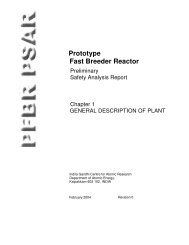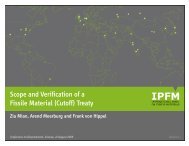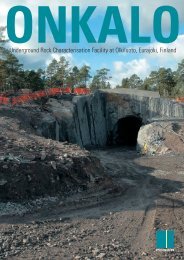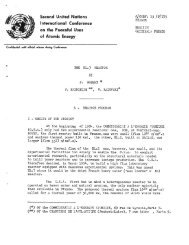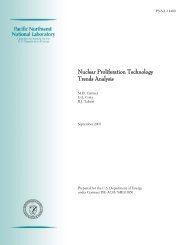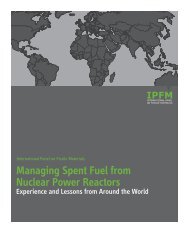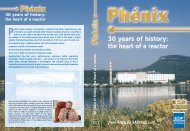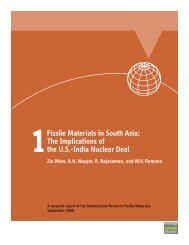Global Fissile Material Report 2009: A Path to Nuclear Disarmament
Global Fissile Material Report 2009: A Path to Nuclear Disarmament
Global Fissile Material Report 2009: A Path to Nuclear Disarmament
You also want an ePaper? Increase the reach of your titles
YUMPU automatically turns print PDFs into web optimized ePapers that Google loves.
ForewordOver the past year, the importance of charting a new common ground for reducing andeliminating s<strong>to</strong>ckpiles of the key nuclear weapon materials—plu<strong>to</strong>nium and highlyenriched uranium—has grown. It is not merely that the <strong>Fissile</strong> <strong>Material</strong> Cu<strong>to</strong>ff Treaty,which would s<strong>to</strong>p all production of fissile materials for weapons, has returned <strong>to</strong>the <strong>to</strong>p of the international nuclear disarmament agenda, with the United NationsConference on <strong>Disarmament</strong> agreeing this year <strong>to</strong> begin talks on such a treaty. Moreimportant, the entire project of nuclear disarmament has undergone a renaissance.Notably, President Barak Obama called in his speech in Prague on April 5, <strong>2009</strong> for aworld without nuclear weapons. The idea of not merely reducing the number of nuclearweapons but of eliminating them entirely is getting more serious consideration than atany time since President Truman proposed the Baruch Plan <strong>to</strong> the UN <strong>to</strong> achieve thisend in 1946.It is in this new context, which is the focus of the present report, that the work ofthe International Panel on <strong>Fissile</strong> <strong>Material</strong>s is playing an indispensable role. Suddenly,people in government, in academia, and in society at large are asking, in more detailthan ever before, what a world with very few or no nuclear weapons might actuallylook like. The difficult and still-important question of how <strong>to</strong> get <strong>to</strong> such a world is nowaccompanied by the perhaps even more difficult and even more important question ofwhat precisely the arrangements in such a world would be and how these would work.The process of getting rid of nuclear weapons (if it really happens), after all, will takeonly a limited time; but the nuclear-weapon-free world will have <strong>to</strong> last forever. Harderthan getting <strong>to</strong> zero will be staying there.The number of nuclear weapons in the world has declined from a peak of more than60,000 at the height of the Cold War <strong>to</strong> about a third of that <strong>to</strong>day. If current talksbetween the Obama administration and the Russian government are successful, thesenumbers will decline further over the next few years, <strong>to</strong> about ten thousand operationalwarheads, including short-range and reserve warheads, plus perhaps anotherthousand in the arsenals of the world’s other seven nuclear powers, with further reductions<strong>to</strong> follow. As the number of weapons declines, the importance of materialsincreases, especially if governments are taking the new goal of zero weapons seriously.In such a world, the immediate fear of nuclear war wanes, and the fear of the return ofnuclear weapons takes its place. Attention turns away from warheads and ballistic missilesand <strong>to</strong>ward uranium enrichment and plu<strong>to</strong>nium separation facilities, plu<strong>to</strong>niumand tritium production reac<strong>to</strong>rs, highly enriched uranium s<strong>to</strong>ckpiles for naval reac<strong>to</strong>rs,civilian s<strong>to</strong>ckpiles of plu<strong>to</strong>nium and the like. <strong>Global</strong> <strong>Fissile</strong> <strong>Material</strong> <strong>Report</strong> <strong>2009</strong>



